Why absurdly enormous bags are here to stay
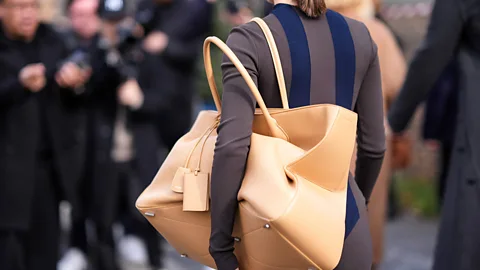 Getty Images
Getty ImagesWith the rise of the ready-for-anything, giant tote, and the recent popularity of a Birkin dupe, we look at the evolution of the It bag and ask what our choice of bag reveals.
If you're the sort of person who likes to be prepared for any eventuality when you leave the house, then you're in luck – one of the biggest accessories trends right now is the supersized handbag. Think slouchy, voluminous holdalls and totes perfect for stuffing with make-up bags, phone chargers, water bottles, books, umbrellas and whatever paraphernalia you need to see you through the day.
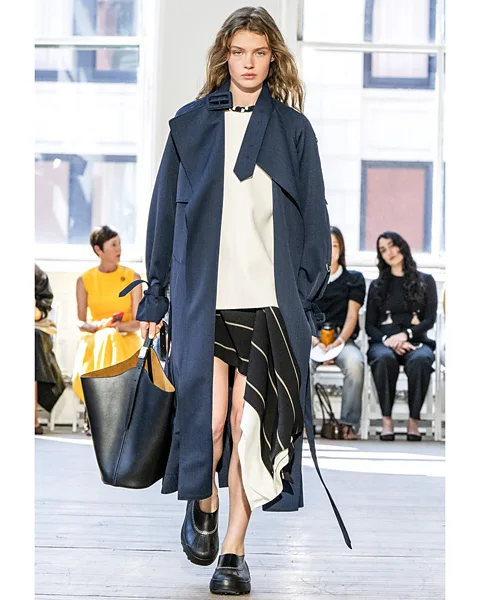 Getty Images
Getty ImagesDesigners aren't always known for prioritising practicality, so this feels like a welcome moment of fashion meeting function. The spring/summer 2025 catwalk shows saw models for Miu Miu, Louis Vuitton and Hermès strut down the catwalk with sensible, spacious doctor holdalls, while at Proenza Schouler they carried giant totes. Last autumn Yves Saint Laurent launched its latest arm candy, the roomy Y – a bag you might actually fit the kitchen sink into – now a favourite with celebrities, including Angelia Jolie and Bella Hadid.
Big bags have been emerging as a trend for a couple of years now. In fact, you could trace their comeback to around the time Matthew Macfadyen's character Tom Wambsgans famously mocked a woman's "ludicrously capacious" handbag on TV drama Succession, a show dedicated to the lives of the super-rich – who don't need to lug anything around for themselves. "What's even in there?" asked Tom. "Flat shoes for the subway? Her lunch pail? It's gargantuan. You could take it camping. You could slide it across the floor after a bank job." The billionaires of Succession might not have approved of voluminous carryalls, but the fashion industry begged to differ.
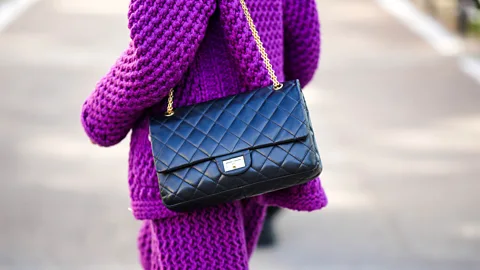 Getty Images
Getty ImagesWhile it might be nice to think the world of high-end fashion is becoming more aware of the needs of the average woman, more likely it's all part of the industry's cyclical nature, which saw micro bags dominating only a few years ago (after all, one of this season's other big trends is bags inspired by the shape of a sausage dog). No sooner have you stuffed your bag with your belongings, there's a new style on the block. And while the latest designs might offer a more practical solution for women, the truth is that a handbag's desirability is rarely down to simple practicality. A bag, especially a designer one, is more than just something to haul things around in. It can also be a status symbol, an item of self-expression and personal identity, or an object of aspiration.
The It bag era
The term "It bag" gained prominence in the 1990s, but the concept dates back decades earlier. In 1955, Coco Chanel created a quilted leather bag with a long chain. The 2.55 – designed to be slung over the shoulder – was revolutionary at the time, offering women a greater freedom than clutch bags or top-handled totes. Seventy years later, it remains one of the most desired designer bags around.
The 1950s also saw Hermès rename one of their bags after Grace Kelly (the actress famously held the bag over her stomach to conceal her pregnancy), while in 1961 Gucci christened their now iconic Jackie handbag. The 1990s and 2000s saw more It bags arrive – Dior's Saddlebag, Chloe's Paddington, the Prada Galleria.
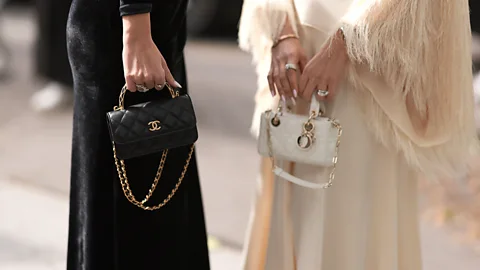 Getty Images
Getty ImagesBut the most coveted of them all emerged in the 1980s, when Hermès launched a bag named after and inspired by actress and singer, Jane Birkin. The Birkin has become the ultimate symbol of exclusivity because, even if you have the money to buy one (we're talking a five-figure price tag), you still have to join a waiting list to purchase it. In one memorable episode of Sex and the City, Samantha goes to extreme lengths to secure a Birkin (the show did a lot to push It bags in popular culture, with the Fendi Baguette also featuring heavily. "It's a Baguette," Carrie Bradshaw famously cried when a mugger demands she hands her bag over.)
Jane Birkin once told Vogue: "I always hang things on my bags because I don't like them looking like everyone else's," and in the early summer of 2023 TikTok was swamped with tutorials on how to "Birkify" your bag by adding trinkets, stickers, ribbons and strings of beads to it. And later that year, the overflowing bag became the accessory of choice – with models for Miu Miu spring/summer 2024 carrying overstuffed bags down the catwalk, calling to mind the "frazzled Englishwoman" aesthetic, embodied by the chaotic film character Bridget Jones.
While the Birkin is an extreme example, exclusivity, whether through price or limited stock, is what has made so many It bags desirable – and aspirational. Those who can't afford a full designer wardrobe might be able to save up and splurge on an expensive bag, which they can wear every day and mark themselves out as a Chloe girl, a Chanel woman or a Loewe lover – or hope that a little magic of the bag's namesakes, whether Mulberry's Alexa (inspired by British model Alexa Chung), or the Lady Dior (Princess Diana), to rub off on them.
But with the price of designer bags skyrocketing in recent years (a Chanel 2.55 has doubled in price over the past decade, now retailing at more than $10,000 or £8,208), owning one has moved on from aspirational to totally unobtainable for most of us. In fact, luxury fashion is in the midst of an existential crisis. Sales are down, with a reported 50 million people stopping buying luxury brands. Many think the costs are way out of proportion to the quality.
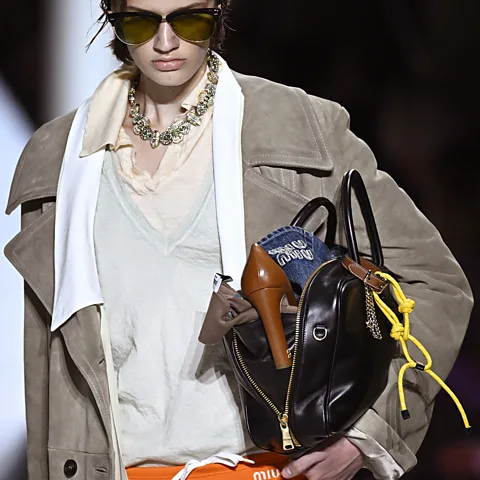 Getty Images
Getty ImagesSo is the It bag era over? Not really, it's just that the must-have bags have shifted from high-end fashion to something more attainable – and utilitarian. Uniqlo's curved cross-body bag and Lululemon's Everywhere belt bag are ubiquitous on city streets, while TikTok made Baggu’s nylon shopper bags a sensation, and the Cos quilted bag is beloved by the fashion set.
Even celebrities have started carrying less attention-grabbing bags – Singapore brand Aupen's mid-priced, understated shoulder bags are loved by Taylor Swift, Hailey Bieber and Kylie Jenner.
Meanwhile, dupes have lost much of their stigma, especially among Gen Z. Getting the look for less is as much of a win as scoring the real thing. Just look at the recent "Wirkin", Walmart's take on the Birkin, which might have briefly been just as sought after as the original. And for those who do want to invest in a classic It bag, preloved options are often more appealing.
In an attempt to revive interest, some designers are wheeling out the old classics. Last year, Balenciaga relaunched its Motorcycle bag – a favourite of Kate Moss in the early 2000s. Now named Le City, Moss is even back to help sell it. Priced $2,900 (£2,377), it's a relative bargain in the current luxury handbag world.
There may be life in the designer bag yet. Charli XCX is the face of JW Anderson's Corner Bag, and recently performed on SNL with a Gucci Jackie bag slung over her shoulder. If anyone can put something in the zeitgeist, it's her.
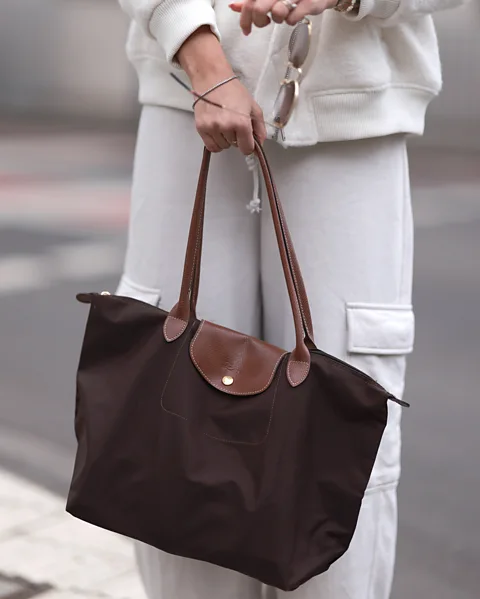 Getty Images
Getty ImagesPerhaps a sign that affordability and practicality – coupled with a classic design and some brand recognition – are what people want from a bag right now is the recent revival of Longchamp's Le Pliage, a lightweight foldable tote that first launched in 1993. It's not the sexiest of armwear, but Gen Z have fallen for it hard, and sales of the $155 (£127) bag are soaring. It's also another pleasingly roomy tote – so perhaps big bags really are back, at least for now.
Perhaps more interesting than which bag we carry, though, is what's inside it – hence the enormous popularity of videos in which people spill the contents of theirs, whether social media influencers or A-listers for Vogue (Florence Pugh carries bottles of hot sauce in hers). In which case, let's hope big bags – and all we can fit inside them – are here to stay.
--
If you liked this story, sign up for The Essential List newsletter – a handpicked selection of features, videos and can't-miss news, delivered to your inbox twice a week.
